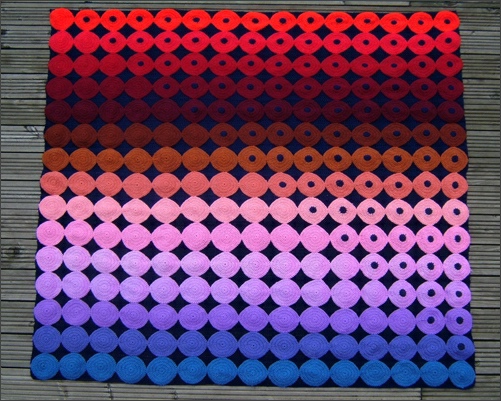




The circles of Try Angulate look rather like the playing pieces for Granny’s Ludo so that is almost certainly where the idea for the construction was triggered.
Mathematically, it was to represent Triangular Numbers. Part of the reason for Double Vision had been for teaching Triangular Numbers but this purpose was rather overwhelmed by the dazzling colour combinations. Try Angulate also has striking colours but its purpose is clearer.
Triangular Numbers are the numbers you get when you start at 1 and add consecutive numbers. The first is 1, the second is 3 (1 + 2), the third is 6 (1 + 2 + 3) and so on. Try Angulate shows two sets of Triangular Numbers. The plain circles represent the fifteenth number, which is 120. The circles with black centres represent the fourteenth number, which is 105. Two consecutive triangular numbers added together make a square number. Physically, the two triangles placed together form a square. In this case the total number of circles is 225 which is the square of 15.
There were some technical difficulties in this design. Firstly, circles will not join together and support themselves. At best each circle can only touch six others and as we wanted these to be in straight lines each could only touch four others. The afghan would need a backing.
The first main problem was choosing the colours. Trying to find fifteen colours in a pleasing sequence is a long job and could only be accomplished in a yarn shop with tolerant staff. We have never resorted to dyeing our own yarns but for those who do this type of design is ideal. We drove about a hundred miles to a shop where there was lots of space to deliberate and where we knew we would find simple double knitting yarns in a wide range of colours. It must have taken about two hours of placing and replacing balls of yarn on the stone floor until we were happy with the array of colours. We arrived at 15 different colours starting with blue and shading through lilac, pinks, peaches and many shades of red. There were to be 15 circles in each of the 15 colours making a total of 225. On reflection, a smaller number of larger circles would have been less tedious to make. I had had enough of circles by the time I finished these but the shading was very effective.
This piece is now the first to be seen as we enter our hallway. It casts a rainbow glow through the glass front door. It is a very welcoming sight.
The other problem was how they were to be supported. The background consisted of a very basic piece of navy crochet the same width as 15 of the circles. It would obviously be difficult to completely attach the circles, as the piece progressed, but anchoring them as much as possible would save a lot of effort and counting later. The circles would only touch halfway up each row and where one row met the next, but that touching point, running across halfway up each row, would be ideal for ensuring they all lined up properly and were equally spaced. They couldn’t be joined with the navy background colour as dark stitches would have been very obvious if they came through to the front of the coloured circles. Along this line the background had to be the same colour as the circles. Problem solved. Running behind each row of circles is a coloured stripe. Not only did this solve the immediate problem but it looks attractive too. The afghan can be used either way round for completely different effects.
